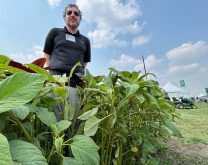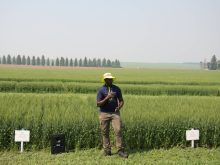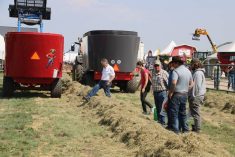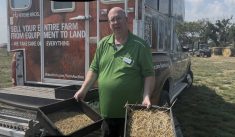The benefits of shelterbelts to forages and cash crops have been known for decades, and as a result, have been a common practice across the Prairies for many years.
Shathi Akhtar, an Agriculture Canada research scientist, has been investigating a new take on shelterbelts by intercropping berry bushes and fruit and nut trees with annual and perennial crops. She’s been working on this project for quite a while, and is happy to be showcasing it at Ag in Motion 2025 near Langham, Sask.
Follow all our Ag in Motion coverage here
Read Also

Using artificial intelligence in agriculture starts with the right data
Good data is critical as the agriculture sector increasingly adopts new AI technology to drive efficiency, sustainability and trust across all levels of the value chain.
The difference between this method of growing trees and bushes and traditional shelterbelts is the additional value for the producer from a fruit or nut crop. As well certain species are better for moisture conservation and nitrogen fixing.
“We are seeing some enrichment in soil nutrients in terms of nitrogen because both sea buckthorn and buffalo berry are nitrogen fixing crops,” she said.
“And they are close to 10 years old now, so they … could provide maximum benefit to the adjacent crop.”
The site Akhtar speaks of is at Agriculture Canada’s research centre at Indian Head, Sask., and has been in production for nearly a decade. As a result, she is able to see the benefits this intercropping can have. It uses sea buckthorn and buffalo berry, alongside annual crops and perennial legumes.
Other trial sites in Saskatchewan are at Carry the Kettle First Nation and Cowessess First Nation. There is also a site in Nova Scotia and British Columbia, with every site growing different species.
“The goal is to see how different regions in Canada, using the fruit trees that traditionally grow there and designing those intercropping style with annual or perennial crops, whether it is a cereal, or oilseed crop, or it is a forage crop, how does it perform? And is there differences in soil zones, differences in climate and all of those. We’re trying to actually tackle quite a lot of things in this project.”
At Carry the Kettle, the researchers chose to integrate buffalo berry, saskatoon berry, apple and grape, intercropped with a forage stand for cattle grazing. The site is established but fairly new, with small trees and a forage stand that hasn’t had a strong start yet.
Akhtar is keeping an eye on the site throughout the summer and will be evaluating it in the fall to see if dormant seeding is needed.
“We’ll add some legume and some native grasses to sort of like bring back the forage side of the story,” she said.
“Trees will take time. Trees take, in this case, five to six years to even see any meaningful tree influence on the ground. So, I don’t expect to see any drastic difference in the first couple of years.”
She said there is no reason to worry about establishment competition.
“Trees will send their roots much deeper in the soil compared to the forage grass or legume that is there. And so technically, they are not competing for water and nutrients, but it’s more of a mutualistic relationship, where they’re helping each other.”
The expected outcome is to see improvements in soil health and carbon, microclimate modifications, such as wind, temperature and humidity, and reduced evapotranspiration, which will be beneficial in persisting drought conditions.

Additionally, the trees help with holding snow for spring melt and protecting crops from wind. This works especially well because in part of Akhtar’s trial, the alleys between tree belts are narrower than traditional shelter belts.
Instead of a few hundred metres, the alley widths are 15 to 26 metres wide to allow for easy equipment use but maximum crop protection. A few different widths, typically 15, 20 and 26 meters, are used to compare production benefits.
“At the end of the day, it would be the cost and benefit analysis from the farmer’s perspective,” she said.
“Environmental and ecological benefits are important, but unless it checks off on the agronomic side, I don’t think we’ll get much adoption.”
Another environmental benefit is increased biodiversity. Akhtar said that at the well-established site near Indian Head, they’ve been seeing higher numbers of birds, insects, and animals, including birds listed as at risk.
The economic benefits have been noticed in the trials that use hazelnuts alongside fruit trees. It is a high value crop and is in high demand. Akhtar believes it could become a new crop for the province, should intercropping trials be successful.
















